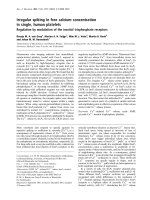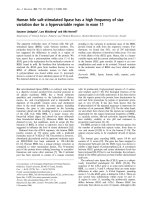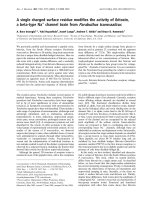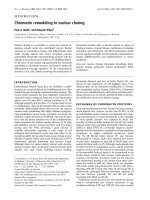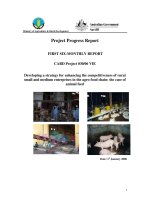Báo cáo y học: "CpG Immunotherapy in Chenopodium album sensitized mice: The comparison of IFN-gamma, IL-10 and IgE responses in intranasal and subcutaneous administrations" docx
Bạn đang xem bản rút gọn của tài liệu. Xem và tải ngay bản đầy đủ của tài liệu tại đây (234.43 KB, 5 trang )
BioMed Central
Page 1 of 5
(page number not for citation purposes)
Clinical and Molecular Allergy
Open Access
Research
CpG Immunotherapy in Chenopodium album sensitized mice: The
comparison of IFN-gamma, IL-10 and IgE responses in intranasal
and subcutaneous administrations
Tahereh Mousavi*
1
, Nader Tajik
1
, Maziar Moradi
2
and
Masoomeh Fallah Radjabzadeh
1
Address:
1
Department of Immunology, Iran University of medical sciences, Shahid Hemmat highway 14496, Tehran, Iran and
2
Department of
Social Medicine, Iran university of Medical Sciences, Shahid Hemmat highway 14496, Tehran, Iran
Email: Tahereh Mousavi* - ; Nader Tajik - ; Maziar Moradi - ;
Masoomeh Fallah Radjabzadeh -
* Corresponding author
Abstract
Background: Mucosal-based immunotherapy has been already used as an alternative form of
allergen delivery. In asthma, the poor success rate of immune modulation could be a consequence
of inadequate immune modulation in the airways. Previously, we have found that subcutaneous
(S.C) co-administration of a homemade allergenic extract from Chenopodium album (Ch.a) pollen
and Guanine-Cytosine containing deoxynucleotides (CpG-ODNs) is effective to prevent the
inflammatory responses in mouse. In this study we used CpG/Ch.a for immunotherapy of Ch.a-
induced asthma and compared the intranasal (I.N) and S.C routes of administration concerning IFN-
γ, IL-10 and total IgE responses.
Methods: Ch.a sensitized mice were treated intranasaly or subcutaneously using CpG and Ch.a.
extract. IFN-γ, IL-10 and total IgE were measured in supernatant culture of splenocytes and
bronchoalveolor lavage (BAL) fluids by ELISA. Student's t test was used in the analysis of the results
obtained from the test and control mice.
Results: We found that I.N administration of CpG/Ch.a in sensitized mice significantly increased
the production of systemic and mucosal IFN-γ and IL-10 compared to phosphate buffered saline
(PBS), Ch.a alone and control ODNs treated sensitized mice (P ≤ 0.001). On the other hand, S.C.
route induced the systemic and mucosal IFN-γ in the lower levels than in I.N one, and failed to
increase systemic IL-10 induction (P = 0.06). Total serum IgE in CpG/Ch.a treated mice in both
routes showed significant decreases compared to three control groups (P ≤ 0.01). The amounts of
IgE in BAL fluids were not measurable in all groups.
Conclusion: According to the results of this experiment we concluded that immunotherapy via
the I.N co-administration of CpG/Ch.a in comparison with S.C route is more effective to stimulate
the mucosal and regulatory responses in Ch.a induced asthma.
Published: 17 September 2008
Clinical and Molecular Allergy 2008, 6:10 doi:10.1186/1476-7961-6-10
Received: 13 April 2008
Accepted: 17 September 2008
This article is available from: />© 2008 Mousavi et al; licensee BioMed Central Ltd.
This is an Open Access article distributed under the terms of the Creative Commons Attribution License ( />),
which permits unrestricted use, distribution, and reproduction in any medium, provided the original work is properly cited.
Clinical and Molecular Allergy 2008, 6:10 />Page 2 of 5
(page number not for citation purposes)
Background
Immunomodulatory agents and their applications in
allergic diseases have become one of the most investigat-
ing subjects in recent years [1,2]. Because of their poten-
tials in immune response deviations, CpG-ODNs are used
to shift immune response toward Th
1
and regulatory
cytokine induction. These cytokines can ultimately lead to
prevention or reduction of pathologic features in asthma
and other allergic conditions [3,4]. There have been many
reports on beneficial properties of CpG motifs used in
combination with different antigens from all over the
world [5-8]. Furthermore, the route of administration is
an attractive subject among these studies [9,10].
In the present study we aimed to compare a number of the
immunomodulatory effects of I.N and S.C co-administra-
tion of CpG motifs in combination with allergen of
Chenopodium album (Ch.a) in Ch.a sensitized mice. The
antigen used in this study was a crude allergenic extract
prepared from Ch.a pollen which is one of the most com-
mon allergenic agents in Iran. Previously we had demon-
strated the potentials of this extract to develop an
experimentally induced asthma in mouse. We also
showed the preventive effects of CpG motifs administered
with Ch.a extract at the sensitization stage [11,12].
Since the usage of adjuvant like CpG motifs for mucosal
immunotherapy was successful [13], we aimed to com-
pare the potentials of I.N. and S.C administrations of
CpG/allergen in mouse model of asthma. In order to com-
pare the effects of different administration route of CpG,
we selected a number of immunological parameters such
as IFN-γ, IL-10 and IgE. Indeed, the measurement of
immune responses regarding T
H
1 and regulatory activities
could be the indicators for evaluating and choosing the
appropriate route for CpG/allergen co-administration.
Methods
Antigen
allergen extract was prepared according to previously
reported procedure [14]. Briefly, the pollen grains col-
lected from the flowering Ch.a. plant were immediately
vacuum dried at 35°C, purified up to 98% through siev-
ing, defatted with acetone, dried and extracted in PBS
(0.02 M, pH = 7.4) overnight at 4°C. The filtered solution
then was dialyzed against PBS and sterilized by 0.22 μm
filtration.
Oligonucleotides
The CpG-ODNs contain two CpG motifs (ODN 1826)
and control ODNs lacking CpG motifs (ODN, 1826 Con-
trol) were purchased from In vivogen, USA. The complete
sequences for CPG-ODNs and ODNs control are as fol-
lows respectively: 5'-tcc atg acg ttc ctg acg tt-3' and 5'-tcc
atg agc ttc ctg agc tt-3'
Animal immunization
Inbred female BALB/c mice aged in 4–6 weeks were pur-
chased from Razi institute in Iran. All experiments com-
plied with the requirements of the animal care committee
of Iran University of medical sciences. Using previously
reported protocols [[11,15] and [16]], Mice were immu-
nized on day 1 and 7 IP with 50 μg Ch.a precipitated in 4
mg aluminium hydroxide in 200 μl PBS and followed by
aerosol challenge of 1% Ch.a (1 mg Ch.a extract in 100 ml
PBS) on days 14 and 16 for 30 min.
Immunotherapy
For treatment, sensitized mice were divided into I.N and
S.C groups. Each group was then randomly subdivided
into four (10 in each) as following:
CpG/Ch.a = sensitized mice treated with Ch.a and CpG
mixture (50 μg/10 μg respectively). Ch.a = sensitized mice
treated with Ch.a alone (50 μg). PBS = sensitized mice
treated with PBS. ODN/Ch.a = sensitized mice treated
with non CpG ODN control (50 μg/10 μg respectively).
I.N treatment was done on day 19, 26 and 33 in I.N group
as mentioned above. S.C treatment was done on day 19
and 26 for mice which were considered as S.C group.
Finally, all groups of mice were secondly exposed to aero-
sol allergen (1%) on day 40 and 47 for 30 min.
Sample preparation
Blood samples were collected from all mice two days after
the final antigen challenge on day 49 and separated sera
were stored at -20°C for IgE assays. Spleens were also
excised on day 49 and single cell suspensions were cul-
tured in complete medium (5 × 10
6
cells/ml in RPMI, 10%
FCS, 100 U/ml pen/strep) in the presence of 50 μg/ml of
allergen for 72 hrs at 37°C in 5% Co2. Cell culture super-
natants prepared from all mice were stored at – 80°C for
cytokine assays.
Bronchoalveolar lavage fluids were prepared according to
previously reported methods [11,12]. Briefly, therachea
was canulated and BAL fluids were obtained by lavaging
lungs with two 0.5 ml of cold PBS.
Cytokine assay
IL-10 and IFN-γ were measured in splenocytes culture
media and BAL Fluids using mouse IL-10 ELISA set, cat.
no. 555252 and mouse IFN-γ ELISA set, cat. no. 5518660
respectively (BD Biosciences, USA). Tests were done
according to the manufacturer's recommendations.
IgE assay-ELISA was performed for total serum IgE assay
using Becton Dickinson opteia mouse IgE set, cat
no.5552448, (BD, USA). According to the manufacturer
the lower detection limits of the assay system was 2 ng/ml.
Clinical and Molecular Allergy 2008, 6:10 />Page 3 of 5
(page number not for citation purposes)
Statistics
Data were expressed as mean ± SD. Each experiment was
repeated twice. Student's t-test was performed for statistic
analysis.
Results
Our results demonstrated elevated levels of IFN-γ produc-
tion from splenocytes after both I.N and S.C treatment
with CpG/Ch.a compared to Ch.a alone, PBS and CpG/
ODN controls (P ≤ 0.001). Furthermore, as presented in
Figure 1(a) IFN-γ production from splenocytes in I.N
treated mice both in CpG/Ch.a and in ODN/Ch.a treated
mice are significantly higher than those in Ch.a alone and
PBS treated mice.
Respecting IL-10, I.N treatment with CpG/Ch.a showed
significant increases in systemic IL-10 levels compared to
all controls (P ≤ 0.001). But, the mean systemic concen-
trations of this cytokine in S.C treated mice with CpG/
Ch.a were lower in comparison with those in Ch.a and
PBS controls, and higher than those in ODN/Ch.a con-
trols (P ≤ 0.01) as shown in figure 1(b).
In order to analyze the effect of I.N versus S.C administra-
tion of CpG in mucosal responses we measured the IL-10
and IFN-γ in BAL fluids of different groups of mice. We
found that IFN-γ and IL-10 were both increased in BAL
fluids and results demonstrated that independent to
administration route, CpG/Ch.a treatment significantly
increased the production of these cytokines (P ≤ 0.001).
As shown in figure 1(c) and 1(d), the route of administra-
tion did not affect the production of cytokines in BAL flu-
ids and no significant changes were shown in cytokine
levels between either route of administration (P = 0.06).
Total serum IgE in CpG/Ch.a treated mice decreased sig-
nificantly compared to control groups independent to
administration routes (P ≤ 0.01). But the amount of IgE
was not detectable in BAL fluids as shown in figure 1(e).
Discussion
At the present time there are many reports on CpG-ODNs
used with different allergens [17,18]. But, there is no
report in the literature regarding the mechanisms for
immunomodulatory effects of CpG-ODNs on Ch.a
induced asthma. In this study we compared the effective-
ness of CpG components for I.N and S.C immunotherapy
of mice sensitized by Ch.a, allergenic extract. This extract
was made from one of the common allergenic pollen in
our country. For this goal we evaluated a number of sys-
temic and local immunomodulatory effects of CpG motifs
in Ch.a induced asthma. We measured IFN-γ, IL-10 and
IgE as the Th1, T-reg and Th2 like responses, respectively.
In consistence with other reports [6,10], we found in our
study the increased IFN-γ production in splenocytes cul-
ture supernatants as well as in BAL fluids after CpG/Ch.a
therapy. These results indicated the potentials of CpG
motifs to enhance the systemic and local Th
1
like
responses in Ch.a sensitized mice. However, concerning
IFN-γ production, our results indicated that I.N adminis-
tration of CPG motifs was more effective than S.C route.
Thus, according to a number of studies [19,20], we can
suggest that this effect could be attributed to expression of
TLR-9 and also the presence of dendritic cells in the nasal
epithelium.
Recently, induction of IL-10 has been proposed as an
important mechanism of immunotherapy [15,21]. Simi-
larly, our data showed that I.N treatment of mice
increased the systemic and mucosal levels of IL-10 as a
regulatory cytokine. However, our results indicated that
S.C administration of CpG/Ch.a enhanced the local eleva-
tion of this cytokine but failed to increase the systemic IL-
10. Interestingly, we found not only the elevation, but
also the reduction in systemic IL-10 in S.C treated mice.
This effect indicates the potentials of I.N but not S.C route
to stimulate both the spleen and lung lymphocytes to pro-
duce IL-10 cytokine. Therefore, based on the study of
Macubas et. al [13] which reported that respiratory toler-
ance is mediated by IL-10 producing dendtitic cells in
lung leading to development of T-reg cells, we can suggest
that I.N administration of CpG/Ch.a may activate the T-
reg populations in lung and spleen of Ch.a sensitized
mice. This result could indicate the advantage of I.N route
of administration in CpG/Ch.a therapy of asthmatic mice.
On the other hand, we found the significant increases in
IL-10 levels after I.N therapy not only with CPG, but also
with non-CPG containing ODNs. These effects for CpG
negative control were not observed in S.C. administration
route. According to Sano et al [22] who observed that
non-CpG ODNs trigger Th2-biased immune stimulation,
it seems that immunoregulatory effects of DNA compo-
nents could be partly due to development of T-reg
responses, especially when they are used through mucosal
surfaces. Considering the reports about the participation
of regulatory cells and molecules in the down modulation
of immune responses in asthma [21], we suggest that
intranasaly co-administration of allergenic extract from
Ch.a pollen and CpG motifs in Ch.a induced asthma acti-
vates the systemic and local IL-10 producing T-reg cells.
However, further studies are necessary to show that the T-
reg cells in the lung are responsible for the induction of
tolerance through the I.N administration of CpG/Ch.a. in
sensitized mice.
Regarding T
H
2 responses, our study indicated a decrease
in total serum IgE following the CpG immunotherapy. In
contrast to Mo JH [17] we and Suzuki et al [23] detected
the significant declines in IgE antibodies after CpG ther-
apy. As the IgE detection in BAL fluids was impossible, we
Clinical and Molecular Allergy 2008, 6:10 />Page 4 of 5
(page number not for citation purposes)
The comparison of cytokines and antibody levelsFigure 1
The comparison of cytokines and antibody levels. The mean values of systemic and local concentrations of cytokines
and IgE antibody measured by ELISA in S.C and I.N CpG/Ch.a treated asthmatic mice in comparison with Ch.a, PBS and ODN
treated controls. (a): IFN-γ produced by splenocytes in CpG/Ch.a treated mice are increased in both routes of administrations,
(b): IL-10 induced by splenocytes suppressed in S.C and enhanced in I.N routes, (c and d): IFN-γ and IL-10 in BAL fluids are
equally increased in both S.C and I.N treated mice with CpG/Ch.a. (e): total serum IgE decreased in mice treated with CpG/
Ch.a through I.N or S.C routes. P values in all analysis are as ≤ 0.01.
(a)
0
200
400
600
800
1000
1200
1400
1600
1800
CpG/Ch.a. Ch.a. PBS ODN/Ch.a.
trated mice
systemic IFN-gamma
(pg/ml)
(SC) (I.N)
(b)
0
100
200
300
400
500
600
700
800
900
CpG/Ch.a. Ch.a. PBS ODN/Ch.a.
trated mice
systemic IL-10 (pg/ml
)
S.C I.N.
(e)
0
10000
20000
30000
40000
50000
60000
70000
CpG/Ch.a. Ch.a. PBS ODN/Ch.a.
trated mice
totalserum IgE (ng/ml)
S.C. I.N.
(c)
0
50
100
150
200
250
CpG/Ch.a. Ch.a. PBS ODN/Ch.a.
treated mice
BAL IFN gamma (pg/ml)
S.C. I.N.
(d)
0
20
40
60
80
100
120
140
160
180
200
CpG/Ch.a. Ch.a. PBS ODN/Ch.a.
trated mice
BAL IL-10 (pg/ml)
S.C. I.N.
Clinical and Molecular Allergy 2008, 6:10 />Page 5 of 5
(page number not for citation purposes)
would suggest the further evaluation of local Th2
responses such as eosinophilia in the BAL or airway hyper
responsiveness.
On the other hand, In the case of route of administration
and chemical component of allergen in CPG-based
immunotherapy, considering other reports studding on
other allergic conditions than on asthma [24], and also
according to Suzuki et al [23] reporting the usefulness of
CpG-ODNs in intranasal administration for control of
allergic rhinitis to Japanese cedar, we showed that for
immunotherapy of Ch.a sensitizes mice, nasal route
which is the natural way to induce asthma could be more
effective than S.C one. Moreover, in consistence with
other reports indicating the advantage of allergenic pro-
teins over peptide epitops in immunotherapy [25], our
study indicated that the crude allergenic protein which is
simply prepared from Ch.a pollens is a suitable material
for in vivo application in mice.
Conclusion
Taken together, treatment of Ch.a induced asthma in mice
via the I.N co-administration of CpG motifs with a crude
extract of Ch.a pollen would be very effective compared to
S.C route of administration. However, the further studies
are needed to indicate the beneficial effects of this proto-
col in the field of human immunotherapy.
Competing interests
The authors declare that they have no competing interests.
Authors' contributions
TM and NT have designed the study and performed exper-
iments, MM performed the statistical, MFR have worked
on the draft versions of the paper. All authors have revised
the final version.
Acknowledgements
This study is financially supported by Iran University of medical sciences.
We wish to thank Dr Nazanin Mojtabavi for her valuable helps and critical
review of the paper.
References
1. Doina M, Racilam JN, Kline M: Perspectives in asthma: Molecular
use of microbial products in asthma prevention and treat-
ment. J Allergy Clin Immunol 2005, 116(6):1202-1206.
2. Jain VV, Kline JN: CpG DNA: immunomodulation and remod-
eling of the asthmatic airway. Expert Opin Biol Ther 2004,
4(9):1533-40.
3. Ikeda RK, Nayar J, Cho JY, Miller M, Rodriguez M, Rosa DS: Resolu-
tion of airway inflammation following ovalbumin inhalation.
Comparison of ISS DNA and corticosteroids. Am J Respir Cell
Mol Biol 2003, 28:139-142.
4. Krieg AM: CpG motifs in bacterial DNA and their immune
effects. Annu Rev Immunol 2002, 20:709-760.
5. Liu N, Ohnishi N, Ni L, Akira S, Bacon KB: CpG directly induces
T-bet expression and inhibits IgG1 and IgE switching in B
cells. Nat Immunol 2003, 4:687-693.
6. Linghua Z, Xingshan T, Fengzhen Z: In vivo oral administration
effects of various Oligodeoxynucleotides containing syn-
thetic immunostimulatory motifs in the immune response
to psodorabied attenuated virus vaccine in newborn piglets.
Vaccine 2008, 26(2):224-233.
7. Klinman DM: Therapeutic applications of CpG-containing Oli-
godeoxynucleotides. Antisense Nucleic Acid Drug Dev 1998,
8(2):181-184.
8. Hussain I, Jain VV, Kitagaki K, Businga TR, O'Shaughnessy P, Kline JN:
Modulation of murine allergic rhinosinusitis by CpG oligode-
oxynucleotides. J Laryngoscope 2002, 112(10):1819-26.
9. Broide DH, Stachnick G, Castaneda D, Nayar J, Miller M: Systemic
administration of immunostimulatory DNA sequences
mediates reversible inhibition of Th2 responses in a mouse
model of asthma. J Clin Immunol 2001, 21:175-182.
10. Jain VV, Businga TR, Kitagaki K, George CL, O'Shaughnessy PT, Kline
JN: Mucosal immunotherapy with CpG oligodeoxynucle-
otides reverses a murine model of chronic asthma induced
by repeated antigen exposure. Am J Physiol Lung Cell Mol Physiol
2003, 285(5):L1137-46.
11. Mousavi T, Asadi N, Tebiyanian M: Study of Chenopodium album
allergenic extract to induce allergic asthma in a murine
model. Iranian Journal of Immunology 2005, 2(3):56-59.
12. Mousavi T, Salek Moghadam A, Falak R, Tebyanian M: Co-adminis-
tration of CpG Oligonucleotides and Chenopodium album
extract reverse IgG2a/IgG1 ratios and increase IFN-gamma
and IL-10 production in a murine model of asthma. Iran J
Allergy, Asthma Immunol 2008, 7(1):1-6.
13. Macaubas C, DeKruyff RH, Umetsu DT: Respiratory tolerance in
the protection against asthma. Curr Drug Targets Inflamm Allergy
2003, 2(2):175-86.
14. Mousavi T, Asadi N, Movahedi M: The comparison of conven-
tional and WHO methods for protein determination of aller-
gic extract. Journal of Allergy, Asthma and Immunology 2003,
2(2):107-9.
15. Kunihiko K, Vipul VJ, Thomas RB, Iflikhar H, Joel NK: Immunomod-
ulatory effects of CpG oligos on established Th2 responses.
Clinical and Laboratory Immunoll 2002, 9(6):1260-1269.
16. Wild JS, Sigounas A, Sur N, Siddiqui M, Alam R, Kurimoto M, Sur S:
IFN-γ – inducing factor increases allergic sensitization,
serum IgE, Th2 cytokines and airway eosinophilia in a mouse
model of allergic asthma. The Journal of Immunology 2000,
164:2701-2710.
17. Mo JH, Park SW, Rhee CS, Takabayashi K, Lee SS, Quan SH, Kim IS:
Suppression of allergic response by CpG motif-house-dust
mite conjugate in animal model of allergic rhinitis. Am J Rhinol
2006, 20(2):212-218.
18. Santeliz JV, Nest GV, Traquina P, Larsen E, Wills-Karp M: Amb a 1-
linked CpG oligodeoxynucleotides reverse established air-
way hyperresponsiveness in a murine model of asthma. J
Allergy Clin Immunol 2002, 109:455-462.
19. Fransson M, Benson M, Adner M, Bjornesson S, Erjefalt J, Uddman R,
cardell LO: Expression of Toll-like receptor 9 in nose, periph-
eral blood and bone marrow during symptomatic allergic
rhinitis. Respir Rec 8:17. 2007, feb 38
20. Hartmann E, Graefe H, Hopert A, Pries R, Rothenfusser S, Poeek H,
Mack B: Analysis of plasmacytoid and myeloid dendritic cells
in nasal epithelium. Clin Vaccine Immunol 2006, 13(11):1278-86.
21. Van Scott MR, Justice JP, Bradfield JF, Enright E, Sigounas A, Sur S: IL-
10 reduces Th2 cytokine production and eosinophilia but
augments airway reactivity in allergic mice. Am J Physiol Lung
Cell Mol Physiol 2000, 278:L667-L674.
22. Sano K, Shirota H, Terui T, Hattori T, Tamura G: Oligodeoxynucle-
otides without CpG motifs work as adjuvant for the induc-
tion of the differentiation in a sequence-independent
manner. J Immunol 2003, 170(5):2367-2373.
23. Suzuki M, Matsumoto T, Ohta N, Min WP, Murakami S: Intranasal
CpG DNA therapy during allergen exposure in allergic rhin-
itis. Otolaryngol Head Neck Surg 2007, 136(2):246-251.
24. Inoue J, Yotsumoto S, Sakamoto T, Tsuchiya S, Aramaki Y: Changes
in immune responses to mite antigen sentisized through
barrier-disrupted skin with CPG-Oligo in mice. Biol Pharm Bull
2006, 29(2):385-387.
25. Suzuki M, Ohta N, Min WP, Matsumoto T, Min R, Zhang X, Toida K,
Murakami S: Immunotherapy with CpG DNA conjugated with
T-cell epitope of an allergenic Cry J 2 protein is useful for
control of allergic conditions in mice. Int Immunopharmacol
2007, 7(1):46-54.



